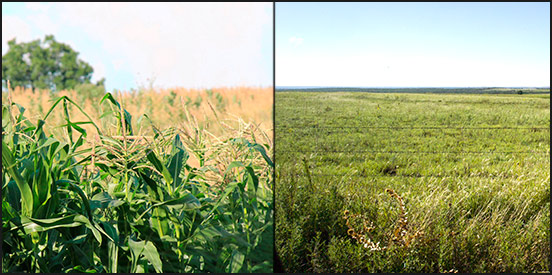In the Cattle Markets
A feed-cost outlook and market update for beef producers.
Looking at the most recent estimates of feedlot profitability, using the Kansas State University (K-State) Kansas Feedlot Net Returns Series, K-State ag economist Glynn Tonsor points out that we saw the largest estimated loss since the series began. There are two sides of the equation when it comes to profitability for both feedlots and cow-calf operations: revenue and costs. With harvest wrapped up across much of the country and many producers already planning for the year ahead, now is the perfect time to take a closer look at the other side of the equation and examine the cost side of cattle production. Typically, the largest component of feed costs for feedlots is corn, while cow-calf producers may be more interested in pasture rent.
One of the better indicators of corn prices tends to be the stocks-to-use ratio. Typically, when stocks as a percent of total utilization exceed 10%, season average farm prices in the United States fall below $4 per bushel (bu.). The most recent USDA World Agricultural Supply and Demand Estimates (WASDE) report projects ending stocks to be around 1.76 billion bu. while total use is projected to be near 13.66 billion bu.
That gives us a stocks-to-use ratio of approximately 12.9% going into the first part of next year. With such a high stocks-to-use ratio, the upside to corn prices will be limited and any movement above $4 per bu. will likely be short-lived. Looking further into the future, corn prices a year from now will be dependent on the size of next summer’s crop.
Recent estimates for 2016 corn acreage have tended to be mixed, with some analysts expecting an increase in acres, while others are expecting lower corn acres. Mississippi State University’s 2016 Crop Planning Budgets are projecting a profit of just less than $120 per acre for the irrigated corn, while last year’s budgets projected a loss.
Other state’s budgets typically yield similar projections, so the numbers seem to point toward a larger 2016 corn crop (barring, of course, any widespread natural disasters). At the same time, there is only limited potential for increased disappearance. Ethanol production has plateaued in recent years, while exports may continue to be limited by a strong dollar. There is potential for increased feed and residual use in 2016-2017, particularly given the growth of the beef herd. Even assuming a small increase in feed use, I don’t foresee the stocks-to-use ratio dipping below 10% in the next year, which should come as good news for many feedlots.
For many cow-calf producers, a large percentage of their feed costs come in the form of pasture rent. There has been much discussion surrounding cropland values, which have increased more than 200%-300% in recent years. Now that crop prices have come back down, many economists are projecting cropland values to drop off significantly over the next few years.
Pasture values and rental rates are the exception to the rule. Pastureland was much slower to rise in value, peaking in 2014-2015 at the same time cattle prices peaked. As cattle prices fall, expect pasture rental rates to fall over the next few years, as well; albeit at a much slower rate than cropland.
Looking forward toward 2016, pasture rental rates will likely be similar to this year primarily because many producers are locked into multiple-year leases that were negotiated at the height of the cattle market. As those leases expire and are renegotiated over the next two to three years, we will see pasture rental rates come back down to where they were a few years ago.

Editor’s Note: Brian Williams is an assistant extension professor in the Department of Agricultural Economics at Mississippi State University.






